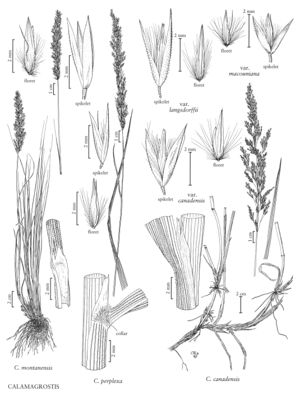Difference between revisions of "Calamagrostis montanensis"
FNA>Volume Importer |
FNA>Volume Importer |
||
| Line 17: | Line 17: | ||
-->{{Treatment/Body | -->{{Treatment/Body | ||
|distribution=Colo.;Minn.;N.Dak.;S.Dak.;Mont.;Alta.;B.C.;Man.;Sask.;Idaho;Wyo. | |distribution=Colo.;Minn.;N.Dak.;S.Dak.;Mont.;Alta.;B.C.;Man.;Sask.;Idaho;Wyo. | ||
| − | |discussion=<p>Calamagrostis montanensis inhabits prairie grass¬lands and sagebrush flats, benchlands, valley bottoms, and occasionally woodlands, at 200-2600 m. It grows in the continental interior from eastern British Columbia (near Fort St. John and Invermere) and adjacent Alberta, south to southern Wyoming and east to Manitoba and western Minnesota. It has also been reported from Peace Point in Wood Buffalo National Park in northeastern Alberta, but this report has not been verified. Calamagrostis montanensis may be mistaken for C. purpurascens (p. 710), but the latter species has hairy adaxial leaf surfaces and longer awns.</p> | + | |discussion=<p><i>Calamagrostis montanensis</i> inhabits prairie grass¬lands and sagebrush flats, benchlands, valley bottoms, and occasionally woodlands, at 200-2600 m. It grows in the continental interior from eastern British Columbia (near Fort St. John and Invermere) and adjacent Alberta, south to southern Wyoming and east to Manitoba and western Minnesota. It has also been reported from Peace Point in Wood Buffalo National Park in northeastern Alberta, but this report has not been verified. <i>Calamagrostis montanensis</i> may be mistaken for <i>C. purpurascens</i> (p. 710), but the latter species has hairy adaxial leaf surfaces and longer awns.</p> |
|tables= | |tables= | ||
|references= | |references= | ||
| Line 26: | Line 26: | ||
-->{{#Taxon: | -->{{#Taxon: | ||
name=Calamagrostis montanensis | name=Calamagrostis montanensis | ||
| − | |||
|authority=(Scribn.) Vasey | |authority=(Scribn.) Vasey | ||
|rank=species | |rank=species | ||
| Line 33: | Line 32: | ||
|basionyms= | |basionyms= | ||
|family=Poaceae | |family=Poaceae | ||
| − | |illustrator=Cindy Roché | + | |illustrator=Cindy Roché;Hana Pazdírková |
| + | |illustration copyright=Utah State University | ||
|distribution=Colo.;Minn.;N.Dak.;S.Dak.;Mont.;Alta.;B.C.;Man.;Sask.;Idaho;Wyo. | |distribution=Colo.;Minn.;N.Dak.;S.Dak.;Mont.;Alta.;B.C.;Man.;Sask.;Idaho;Wyo. | ||
|reference=None | |reference=None | ||
| Line 39: | Line 39: | ||
|publication year= | |publication year= | ||
|special status= | |special status= | ||
| − | |source xml=https:// | + | |source xml=https://jpend@bitbucket.org/aafc-mbb/fna-data-curation.git/src/f50eec43f223ca0e34566be0b046453a0960e173/coarse_grained_fna_xml/V24/V24_1025.xml |
|subfamily=Poaceae subfam. Pooideae | |subfamily=Poaceae subfam. Pooideae | ||
|tribe=Poaceae tribe Poeae | |tribe=Poaceae tribe Poeae | ||
Revision as of 20:17, 16 December 2019
Plants with sterile culms; ces¬pitose, with rhizomes 6+ cm long, 1-2 mm thick. Culms 15-50(54) cm, unbranched, usually scabrous, rarely smooth; nodes 1-2. Sheaths and collars smooth or slightly scabrous; ligules (1)2-3 mm, obtuse to acute, more or less lacerate; blades (5)8-19(23) cm long, (1)2-3(4) mm wide, usually involute, seldom reaching the panicles, abaxial surfaces scabrous, adaxial surfaces usually scabrous, rarely smooth, glabrous or sparsely hairy. Panicles 4-9(14) cm long, (0.7)1-2(3.5) cm wide, erect, contracted and not or only slightly interrupted, yellowish green with a light purple tinge; branches 1.3-3(3.7) cm, sparsely short-scabrous to densely long-scabrous, spikelet-bearing to the base. Spikelets (3)3.5-4.5(7) mm; rachilla prolongations about 1 mm, densely bearded, hairs to 2 mm. Glumes keeled, smooth or scabrous throughout, lateral veins usually somewhat obscure, rarely prominent, apices acute to acuminate, rarely awn-tipped; callus hairs (1)1.5-2(2.5) mm, 0.4-0.8 times as long as the lemmas, abundant; lemmas (2.5)3-3.5(5.5) mm, 0.5-1(2) mm shorter than the glumes; awns (1)2-3(4) mm, usually attached to the lower 1/10 – 2/5 of the lemmas, rarely above the middle, sometimes slightly exserted, stout, distinguishable from the callus hairs, slightly bent; anthers (1.1)1.8-2.4(3) mm. 2n = 28.
Distribution
Colo., Minn., N.Dak., S.Dak., Mont., Alta., B.C., Man., Sask., Idaho, Wyo.
Discussion
Calamagrostis montanensis inhabits prairie grass¬lands and sagebrush flats, benchlands, valley bottoms, and occasionally woodlands, at 200-2600 m. It grows in the continental interior from eastern British Columbia (near Fort St. John and Invermere) and adjacent Alberta, south to southern Wyoming and east to Manitoba and western Minnesota. It has also been reported from Peace Point in Wood Buffalo National Park in northeastern Alberta, but this report has not been verified. Calamagrostis montanensis may be mistaken for C. purpurascens (p. 710), but the latter species has hairy adaxial leaf surfaces and longer awns.
Selected References
None.
